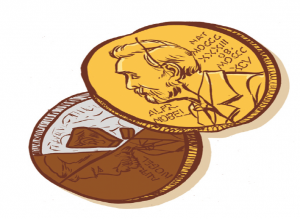FRIDAY, 25 JANUARY 2013
Bottoms UpRarely does progression in scientific research require a level of self-sacrifice that borders on the utterly disgusting. However, in 1983 Soviet virologist Dr Mikhail Balayan used his own body as an incubator for hepatitis E. Previously defined as epidemic non-A, non-B hepatitis by Dr Robert Purcell this virus was noted for its vicious outbreaks, especially amongst pregnant women, a characteristic not seen in other forms of hepatitis. It also proved notoriously difficult to examine due to the relatively scarce numbers of patient samples to test on, a challenge which prevented further identification. Whilst Balayan was studying an outbreak in Soviet-controlled central Asia, he wanted to take some samples back to the laboratory for further study but lacked the refrigeration necessary to transport them. Undeterred, he made a smoothie from yoghurt and stool samples and drank it, travelled back to his lab and waited until he became ill. Using his own stool samples he was able to show that epidemic non-A, non-B hepatitis was similar to hepatitis A and yet a distinct disease. The virus was subsequently sequenced in 1990 and given the new name hepatitis E. China has recently announced development of a new hepatitis E vaccine, meaning that eradication of this disease which claims 70,000 lives a year can finally begin to be realised. Balayan’s contribution was vital to the furthering of knowledge about the virus, but it was probably some time before he could look at a smoothie again! Laura Burzynski
Sweet Victory
Does eating chocolate increase your chances of winning a Nobel Prize? This was the question asked by Frank Messerli at St Luke’s-Roosevelt Hospital in New York. Dietary compounds called flavanols, which are found in cocoa, green tea and red wine, are known to improve cognitive performance. He investigated whether chocolate consumption had an impact on a population’s cognitive function, as measured by the number of Nobel Laureates within particular countries. Of the 22 different countries studied, Switzerland consumes the most chocolate - 11.9kg per person each year - and also has the highest number of Nobel laureates per capita. A similar positive correlation was observed for other countries and Messerli has estimated that it would take an extra 0.4kg of chocolate per person per year in order to increase the number of Nobel Laureates in a given country by 1. Of course other factors were not taken into account such as differences in the level of science funding and social and cultural factors within each country. In addition, the specific chocolate intake of past and present Nobel winners is not known. Nonetheless, if you dream of winning the Nobel Prize, perhaps you should start eating more chocolate! Laura Pearce
The Fern Monster
A lot of biology is about giving names to things, so much so that it has almost become a competition between some researchers to discover new species, proteins, and genes and give them the wackiest names they can imagine. A trend that makes the news every so often, is to name a new species in honour of a celebrity. David Attenborough is a particularly popular target for this, with six species named in his honour, ranging from extinct plesiosaurs to spiders and pitcher plants. Other celebrity-named species include the Schwarzenegger beetle, the Obama lichen and the Pratchett turtle. In a recent paper, a team from Duke University, revealed their decision to name not one species, but a whole group of 19 central and southern American fern species, in homage to Lady Gaga. The new Gaga genus, a group of closely related species, is made up of 17 known species that have been renamed following detailed scientific investigation. There are also two newly reported species, Gaga germanotta, named after the music star’s birth name, and Gaga monstraparva, meaning ‘little monsters’. The team presents many reasons for the association, including a highly characteristic GAGA sequence that is a key part of the genetic code common in all 19 species, as well as the resemblance between the juvenile form of these plants and Lady Gaga’s iconic dress from the 2010 Grammy Awards. However, the final decision was made in order to show support for Gaga’s empowering attitude and support for outcasts and minorities everywhere. Jonathan Lawson



